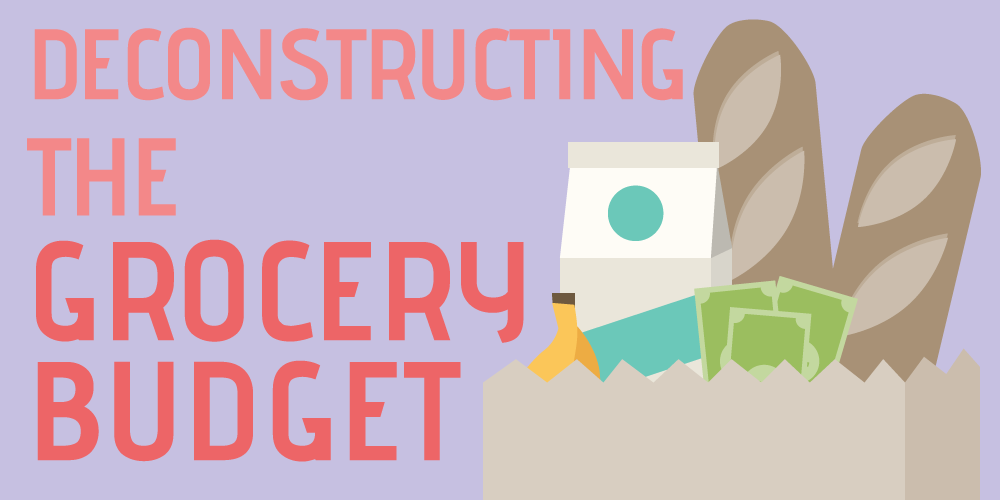If you’ve paid any attention at all to my monthly budget updates, you’ll know that I plan to spend $350 per month on food costs for me only. Since Richard and I split food costs, this means we are budgeting for $700 in food for both of us per month. Clearly, this isn’t a small sum of money. Lately, I’ve been thinking that there is likely a way for us to work to decrease spending in this category. I’ve also been thinking that the number that I’ve put together is pretty arbitrary.
Grocery Desires
Before I get to the numbers, I wanted to articulate what is important to us when we go to the grocery store. I often see people online claiming they spend like $400 for a family of four per month on groceries. As someone who spends wayyy more than that for a household of 2, that seems pretty extreme. It also makes me question: What are you buying? What kind of food are you even making?
The quality of what we are eating is pretty important to both of us, so if $200 is getting us a lot of processed items per month, I’d rather continue paying the $700. So, what is important to us?
- Minimally processed foods
- High protein, low carb diet
- Minimal added sugars
- No artificial sweeteners (ever!)
- High quality coffee
- Quick and easy recipes that can be cooked in double batches
- Some organic items, but not really a necessity
It actually seems like a pretty simple list, but I know it’s harder to translate these wants into a lower grocery budget.
Staples
Each week, we purchase a number of staples that aren’t necessarily incorporated into specific recipes. A typical week (and costs) for our staples includes:
- 3 half gallons of almond milk – $8.97
- 3 packages of dry Roasted Edamame seeds – $5.37
- Wheat fajitas – $2.79
- Peanut butter – $5 (every few weeks)
- 1 to 2 packages of crunchy snacks (e.g. roasted chickpeas, lentil chips) – up to $10
- 8 oz of coffee – about $10 per week
So, each week, we are spending about $40 on staples. Assuming 4 weeks are in a month, we spend $160 on staples. We already get the store brand for almond milk and don’t always get crunchy snacks. The one area I know we can cut back on is coffee. The only problem is that we really enjoy good coffee and haven’t quite found a good place to get whole beans at a reasonable price. The one good thing we have to look forward to is the fact that Richard recently started a new job and isn’t drinking as much coffee at home, which will help reduce our coffee drinking.
Meals Needed
We strive to eat most of our meals at home and try to eat out only one night a week (although, depending on what is happening, it sometimes turns into two nights per week). Now that I’m thinking of trying to really tune our budget and make sure our budget is actually grounded in reality, I figured I would start by figuring out how many meals we need to make from our groceries per month.
Okay, so to break it down, this is the number of meals I need to account for each month:
- Breakfast: 7 days x 2 people x 4 weeks = 56 meals
- Lunch: 5 days x 2 people x 4 weeks = 40 meals
- Dinner: 6 days x 2 people x 4 weeks = 48 meals
For lunches, I assumed that we need to account for 5 lunches per week to account for each of us having the option to buy lunch an average of once per week and having a weekend lunch out. If we eat all breakfasts at home and have dinner out once per week, we need a total of 144 meals per month.
Costs Per Meal
Now that we know how many meals we need and what our staple costs are, we can figure out what our cost per meal should be. Once I know what our per meal costs should be, I can start to figure out two things: a) what our budget should be and b) which recipes will help stay within budget.
Even Cost Per Meal
Our currently budget is $700 per month. Our staples cost around $150 per month. If we assume that the rest of the budget is going to meal costs and all of those meals will cost the same, we should aim to make recipes that cost less than $3.81 per serving.
To give an ideal of how the cost per serving might be affected by different budgets:
- $700 – $160 = $540 or $3.75 per serving
- $600 – $160 = $440 or $3.05 per serving
- $500 – $160 = $340 or $2.36 per serving
- $400 – $160 = $240 or $1.66 per serving
Right now, I’m a little skeptical of the $500 and $400 per month budgets. Trying to stay under $2.50 per serving seems a little unrealistic for all meals considering we do eat meat and value high quality ingredients. But hey, this is still in thought experiment and I might find myself surprised by the number of recipes that I find that meet our grocery needs/desires list.
Breakfasts Cost Less
Another approach we could take is assuming that breakfast costs will be less than lunch and dinner costs. This seems like a reasonable way to plan things, since our breakfasts tend to be hearty but lighter than our lunches and dinners. In general, breakfast ingredients also tend to cost less. Lunch and dinner will always have the same per serving cost, because we do not make special lunches. We simply bring leftovers from dinner for lunch the next day.
If we assume that average breakfast costs will not exceed $2.50 per serving on average, we can figure out what our costs can be for our other meals. If we have 56 breakfasts that cost us $2.49 each on average, that will cost a total of $140 per month. Let’s see how that affects the dinner and lunch per serving costs:
- $700 = $160 staples +$140 breakfasts (56) + $400 (88 meals); $4.54 per lunch/dinner serving
- $600 =$160 staples + $140 breakfasts (56) + $300 (88 meals); $3.40 per lunch/dinner serving
- $500 =$160 staples + $140 breakfasts (56) + $200 (88 meals); $2.27 per lunch/dinner serving
- $400 =$160 staples + $140 breakfasts (56) + $100 (88 meals); $1.13 per lunch/dinner serving
Comparing the two sets of estimates, if we get breakfast down to $2.50 on average, we are given a little more leeway for lunch and dinner when we spend either $700 or $600 total on groceries. However, if we are spending $500 or $400 on groceries, we would actually be spending less on lunches and dinners than we are on breakfasts per serving.
Redefining the Grocery Budget
Now that I have a better idea of what different budgets can get me, it’s time to go out and find some recipes that will help us actually get us there. The most opportunity that I currently see for reducing our grocery budget is in the lunch/dinner category and potentially the breakfast category. I think regardless of where we end up, figuring out the per serving costs of our recipes will be a good gut check for whether or not we should decide to make it and whether or not it aligns with our goal to try to reduce our grocery spending (or at least make it more predictable).


